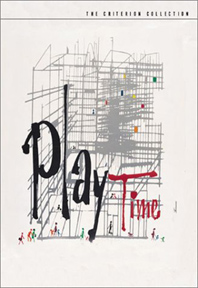 |
Arch 484/684: Architecture and Film Fall 2003: Course Home Page
comments, suggestions for welcome!
|
| Terri Meyer
Boake B.E.S. B.Arch. M.Arch. Associate Professor School of Architecture University of Waterloo |
 |
Arch 484/684: Architecture and Film Fall 2003: Course Home Page
comments, suggestions for welcome!
|
Course
Description: All showings are in ES2-286 @ 10:00 a.m. Everyone is welcome to attend. sample film from Architecture and Film Fall 2002: by Anthony Kwan link |
| Film Name and Details | Reviews/Links: | |
Theme 1: Early Film and Its Use of Architecture as Significant Set |
All of the internet reviews below were active as of August 2002. | |
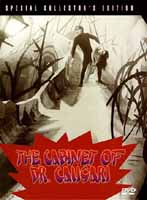 September 10 |
The Cabinet of Doctor Caligari (1920) (72 minutes) The film that forged the dark, ominous cinematic movement known as German Expressionism - and influenced vanguard filmmakers for generations. Werner Krauss stars as a deranged hypnotist who spreads death through the countryside from a ramshackle traveling carnival. In making the film Robert Wiene and designers combined techniques of painting, theatre and film to conjure a nightmare world of splintered reality ... boldly creating a visual representation of insanity .. taking the art of cinema a lengthy stride into unexplored stylistic and psychological terrain, hinting at the terrifying power the medium might possess. |
http://www.film.u-net.com/Movies/Reviews/Cabinet_Caligari.html http://www.geocities.com/Hollywood/Set/9078/cindex.htm http://www.mdle.com/ClassicFilms/FeaturedVideo/video178.htm http://victorian.fortunecity.com/cloisters/511/classics/noir/caligari1.html |
Student Reviews:
Masters Research Paper:
|
||
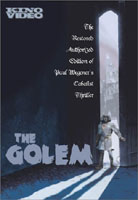 September 10 |
The Golem (1921) (86 minutes): In 16th century Prague,
Rabbi Loew creates a terrifying giant golem from clay to protect his people
from their persecutors. Employing sorcery, he brings the artificial man
to life, endowing him with human emotions. Famulus, Loew’s evil
assistant, manages to take control of the Golem, commanding it to perform
sordid criminal acts culminating in the kidnapping of the Rabbi’s
beautiful daughter, Miriam. The monster, outraged by his vile misuse,
rebels and a deadly rampage ensues. With high, angular sets by famed architect
Hans Poelzig and full of wonderful imagery captured by the camera of Karl
Freund, this silent classic captivates the eye. Masterfully combining
terror and pathos, Wegener’s stiff-limbed portrayal of the golem
clearly influenced Boris Karloff’s performance in Frankenstein.
This 1920 version of The Golem is considered definitive among the film’s
many productions and is an unforgettable horror masterpiece. |
http://www.ced.appstate.edu/projects/fifthd/legend.html http://movies.go.com/filmography/Credits?movie_id=40216 http://www.hamburg.de/Behoerden/Kulturbehoerde/epoc/deutsch/themen/filme/golem.htm http://www.tvguide.com/movies/database/ShowMovie.asp?MI=40216 |
Student Reviews: Diana Zepf link Masters Research Paper: |
||
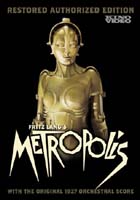 September 17 |
Fritz Lang’s Metropolis (1927) (115 minutes) Fritz Lang's most famous silent film uses science fiction and spectacular special effects to tell a story of biting social criticism. In a futuristic time and place, an above ground city of lightness, culture and respectability is kept going only by the enslaved proletariat laboring beneath in the underground city: a nightmarish, cruel and dark place. An innovative and influential film in its day and now considered one of the hippest films of the sci-fi genre. I have this film in its "common" release as well as the rerelease in 2002 of the restored version. We will be using the recently restored version for the class.
|
http://shipofdreams.net/sfmovies/metropol.htm http://www.kino.com/metropolis/ http://www.uow.edu.au/~morgan/Metroa.html http://www.activitaly.it/immaginicinema/metropolis.html http://www.silentera.com/DVD/metropolis-cmhDVD.html |
Student Reviews: Erik Boyko link Masters Research
Paper: |
||
| Just Imagine (1930) Very rare 1930 science fiction film about futuristic 1980 New York where airplanes have replaced cars and features a combination of booze jokes, sci-fi, lewd sex, vaudeville jokes. Babies are gotten through vending machines, and a trip to Mars proves Martians to be twins, (Each set has a good over-sexed one, and an evil homicidal one.) Pepper this oddity with bad puns, miniature effects, and musical numbers and you got a bizarre wacky film! It stars El Brendel, Maureen O'Sullivan & John Garrick. This is the VHS version. Very strange movie but with some quite interesting presentations of futuristic architecture as well as lifestyle. |
http://www.moviediva.com/MD_root/reviewpages/MDJustImagine.htm |
|
Student Reviews:
Masters Research Paper: |
||
 October 1 |
H. G. Wells’ Things to Come (1936) (97 minutes) One of the most important science fiction films of all time, it opens prior to World War II and takes the viewer on a hundred year time trip to 2036 A.D. when a man and woman are rocketed to the moon. This inspired saga predicts television, jet planes and evil dictators. Featuring fabulous sets, a rich musical score and sweeping visual grandeur. Visionary science fiction novelist H.G. Wells teams up with ace producer Alexander Korda to produce this landmark motion picture epic. A sequel (bad) to this film called "Shape of Things to Come" was done in 1979.
|
http://www.csie.ntu.edu.tw/~ntucs82/PEOPLE/b2506017/sf/1f.html http://icg.harvard.edu/~lit107/Film_Resources/Things_to_Come.htm http://tatooine.fortunecity.com/herbert/305/sfm30-364.htm http://www.wikipedia.com/wiki/H.G.+Wells http://www.kirjasto.sci.fi/hgwells.htm |
Student Reviews: Jonathan Wong link Masters Research
Paper: |
||
| Theme 2: Animated Film's Take on the World of the Future |
||
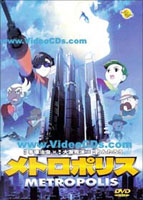 October 8 |
Osamu Tezuka’s Metropolis (Japanese Anime 2001) (109 minutes) "Metropolis is the new milestone in anime. It has beauty, power, mystery and above all... heat. Images from this film will stay with you forever." James Cameron In the industrial tri-level world of Metropolis, Duke Red is a powerful leader with plans to unveil a highly advanced robot named Tima. But Duke Red's violent son Rock distrusts robots, and intends to find and destroy Tima. Lost in the confusing labyrinth of Metropolis, Tima is beginning a friendship with the young nephew of a Japanese detective. But when Duke Red separates the two innocents, Tima's life - and the fate of the universe - is dangerously at stake.
|
http://movies.yahoo.com/shop?d=hv&id=1807599215&cf=info http://www.startribune.com/stories/412/2003304.html http://www.barcelonareview.com/27/e_sitges.htm http://www.npr.org/programs/morning/features/2002/jan/ metropolis/020124.metropolis.html http://www.sonypictures.com/cthv/metropolis/ |
Student Reviews: Duncan Bates link Masters Research Paper: |
||
|
On Your Mark (Studio Ghibli 1995) (6 minutes) In a futuristic Megacity,
a pair of Policemen take part in a raid on a religious cult’s temple.
While searching through the rubble they find a starved and weak young
girl, with angelic wings. Though they revive her, she is carted off by
a biohazard unit, and put under examination. After much deliberation,
they realize that she has simply gone from one prison into another. Together
they hatch a plan to free the girl, and show her the blue sky she belongs
in. You would think that by that synopsis, and the stunning pics, that
this was a one-shot hour-long feature film. And if you did so, you would
be mistaken. Done back in 1995, and paired up in theatres with Mimi
wo Sumeseba, this animated short was the music video presented for
the popular Japanese music duo, Chage & Aska. Running only six minutes,
forty seconds long, and featuring not a word of dialogue, this animated
short manages to tell a touching and amusing story, with only music and
imagery to guide it along. The animation is crisp, as all Ghibli fare,
but the music is every bit as fantastic as the visuals; Chage & Aska
are no J-POP idols of the week, they’ve been around for a good long
while, and as such know how to SING. I rate this right beside Mononoke
Hime for best of all time simply because of what it achieves, with
so little to work with. |
http://www.nausicaa.net/miyazaki/oym/faq.html http://carnage.fanfic.org/onyourmark.html http://ghibli.epistream.com/on_your_mark/ http://www.animetheme.com/animetheme_n6.html? http://www.animetheme.com/mononoke/on_your_mark.html http://www.theroseking.net/animehub/onyourmark.html http://www.ex.org/2.7/17-anime_onyourmark.html
|
Student Reviews:
|
||
| Theme 3: Modern and Contemporary Film and its Vision of Architecture of the Future | ||
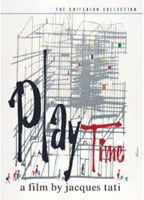 October 15 |
Playtime: Jacques Tati (1973) (119 minutes) Jacques Tati, the choreographer of the charming, comical ballet that is Playtime, casts the endearingly clumsy Monsieur Hulot as the principal character wandering through modernist Paris. Amid the babble of English, French and German tourists, Hulot tries to reconcile the old-fashioned ways with the confusion of the encroaching age of technology. Interesting view of 1960's (Modern) Paris. Intriguing filming, sets and a highlight of the "sounds" of modernity.
|
http://www.futuremovies.co.uk/moviesite/filmmaking.asp?ID=38
http://www.filmwritten.org/essays/JNC_playtime.htm http://media-arts.rmit.edu.au/Phil_Brophy/MMAlec/Playtime.html http://frenchfilms.topcities.com/nf_Playtime_rev.html http://www.rottentomatoes.com/m/Playtime-1016452/ |
Student Reviews: Diane Skilton link Masters Research Paper: |
||
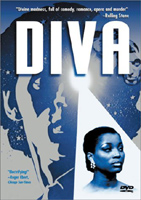 October 22 |
Diva (1981) (118 minutes) Modern noir meets high opera in the French suspense flick Diva. Delivery boy Jules has an opera obsession. He spends his small disposable income on sophisticated sound equipment and manages to bootleg a live performance of his favorite diva, Cynthia Hawkins (played by real-life opera singer Wilhelmina Wiggins Fernandez). But Jules is spotted making the recording by shady investors who want the tape. As if that weren't enough, a second cassette, filled with enough evidence to topple an international drug and prostitution ring, makes its way into Jules's mailbag. Writer-director Jean-Jacques Beineix does a terrific job of adapting Delacorta's pulpy novel for the screen, keeping all the excitement while adding a layer of depth. A movie to make even a dedicated opera hater appreciate a perfectly sung aria, Diva has enormous loft apartments, thugs galore, gorgeous visuals, and a corker of a chase scene.
|
http://www.apolloguide.com/mov_fullrev.asp?CID=402
http://movies.yahoo.com/shop?d=hv&id=1800057873&cf=info&intl=us http://www.allwatchers.com/topics/info_17492.asp http://www.rottentomatoes.com/m/Diva-1005973/reviews.php |
Student Reviews: Anna Jarvis link Masters Research Paper: |
||
 October 29 |
Soylent Green (1973) A future which is possible, but which none of us wants to think about in these days of holes in the ozone and global warming appears in "Soylent Green." New York, with 40,000,000 people, perpetual smog, and constant hot, hot temperatures is grim, to say the least. Charlton Heston does an outstanding performance as Thorn, a harried, overworked police officer who uncovers the horrifying secret of Soylent Green. There is much to like in this movie, a well-crafted look into the near future. One of the most frightening aspects of this video is the state-sponsored suicide clinic, "Home." A poignant aspect of this video is that Edward G. Robinson was actually dying of cancer during the filming and succumbed just a few months later. |
http://www.sciflicks.com/soylent_green/ |
| Student Reviews: Jonah Humphrey link Masters Research Paper: Matthew Tsui link
8.6MB |
||
 November 5 |
Blade Runner (1982) (117 minutes) Rick Deckard (Harrison Ford) prowls the steel and microchip jungle of 21st century Los Angeles. He's a "blade runner" stalking genetically made criminal replicants. His assignment: kill them. Their crime: wanting to be human. The story of Blade Runner is familiar to countless fans. The version we will be viewing is the out of print original cut (only available on VHS) that includes the voiceover narration by Harrison Ford and some footage that was cut from the DVD release. (I have both editions available for the class).
|
http://www.brmovie.com/ http://s.webring.com/hub?ring=bladerunner http://scribble.com/uwi/br/off-world.html http://www.ozcraft.com/scifidu/blade_runner.html http://www.trussel.com/f_blade.htm http://apolloguide.com/mov_revtemp.asp?CId=2301 http://www.filmsite.org/blad.html http://www.blade-runner.it/ |
| Student Reviews: Gabriel Friedman link Masters Research Paper: Ava Franzolini link
(600KB) |
||
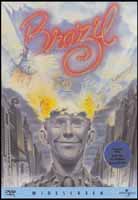 November 12 |
Terry Gilliam’s Brazil (1985) (2 hours 30 minutes) Brazil is a surrealistic nightmare vision of a "perfect" future where technology reigns supreme. Everyone is monitored by a secret government agency that forbids love to interfere with efficiency. Johathan Pryce and Robert De Niro star with Michael Palin in this chilling black comedy directed by former Monty Python member Terry Gilliam. When a daydreaming bureaucrat becomes unwittingly involved with an underground superhero and a beautiful mystery woman, he becomes the tragic victim of his own romantic illusions.
|
http://www.mrqe.com/lookup?^Brazil+(1985) http://www.suntimes.com/ebert/ebert_reviews/1986/01/38231.html http://www.trond.com/brazil/ http://www.smart.co.uk/dreams/ http://www.imagesjournal.com/issue06/features/brazil.htm http://members.aol.com/morgands1/closeup/indices/gillindx.htm http://membres.lycos.fr/brazil/GB/indexgb.htm http://www.faqs.org/faqs/movies/brazil-faq/ |
| Student Reviews: Neil Brun link Masters Research Paper: Graham Wolff |
||
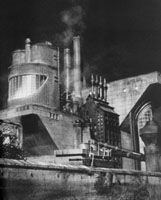 November 19 |
Batman (1989) (126 minutes) Fifty years after Batman's debut as a comic strip in 1939, Warner Bros. turned the theme into a major motion picture with a $27M budget. The film was produced at the Pinewood Studios outside London, which provided spacious soundstages and a 95 acre backlot for the creation of an ambitiously complex city set. Eventually the 400 m long set became the most expensive outdoor set built in Europe since Cleopatra. Created in an astonishingly short time it is also one of the most compelling urban visions in the history of filmmaking.
|
http://feedmyego.com/movies/B/Batman1989.html
http://us.imdb.com/title/tt0096895/ http://movies.yahoo.com/shop?d=hv&cf=info&id=1800340927 http://movie-reviews.colossus.net/movies/b/batman.html http://www.atlyrics.com/quotes/b/batman.html http://www.el-caracho.de/html/models/batmobile.htm http://www.batman-on-film.com/scripts.html http://www.batman-on-film.com/ |
Student Reviews:
Masters Research Paper: Vince Plouffe link
(850KB) |
||
November
26 |
Student Presentations for end of term review everyone is invited to attend!! |
|
| Other Miscellaneous Links: | ||
http://hubcap.clemson.edu/~sparks/sffilm/indexsff.html (fantastic sci-fi film course homepage from Clemson University -- great links and reading references for a wide range of films) http://www.geocities.com/Hollywood/Lot/2976/SF_FilmResources.HTML http://www.lib.berkeley.edu/MRC/Scififilm.html http://shipofdreams.net/sfmovies/movielinks.htm
|
||
| |
||
Attendance: Class time: Undergraduate
Requirements: Assignment #1: The
Review 30% Assignment #2: (B.Arch.)The
Video 50% Graduate
Requirements: Assignment #2: Film
Introduction 10% Assignment #3: Research
Essay 50%
Required. Deitrich Neumann, editor. Film Architecture from Metropolis to Blade Runner. Prestel, 1999. Required. Mark Lamster, editor. Architecture and Film. Princeton Architectural Press, 2000. Donald Albrecht. Designing Dreams: Modern Architecture in the Movies. Hennessey + Ingalls, Santa Monica, 2000. Maggie Toy, editor. A.D. Architectural Design Profile no. 112. Architecture and Film. Academy Group Ltd. 1994. (OUT OF PRINT) Maggie Toy, editor. A.D. Architectural Design Profile no. 150. Architecture + Animation. Wiley-Academy. 2001. (OUT OF PRINT) Francois Penz, editor. Cinema & Architecture: Melies, Mallet-Stevens, Multimedia. British Film Institute, 1997. Thomas Hine. Movie Houses. Architectural Record. 04.02. Terry Smith, editor. Impossible Presence: Surface and Screen in the Photographic Era. University of Chicago Press, 2001.
last updated August 30, 2011 |